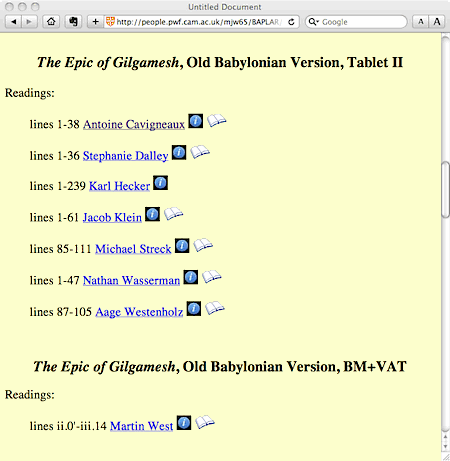SB Tweet Digest #9 (october 2010)
november 19, 2010.
In October there were _174_ SoundBlog
tweets ![]() . Here's a selection, together
with some comments and elaborations.
. Here's a selection, together
with some comments and elaborations.
[26106386780] This 'Speech is Fire' tweet on October 1st links to an 'Untitled Document' on the web site of Cambridge University. It is made up in pre-1995 HTML and some of the corresponding 'old web graphics'. Not for reasons of nostalgia or out of love for a 'vintage web', but because that is the way that a lot of academics continue to present work and material on their (personal) pages: unadorned information in basic fonts and colors, without glitter or design.
Created and maintained by Martin Worthington, this surely is the most intriguing web site that I have visited in a long time. It is about Babylonian and Assyrian, that as spoken languages (in Ancient Mesopotamia) - apparently - disappeared some 2500 years ago. On the site, however, you can *listen* to contemporary scholars having a go at actually reading out Babylonian and Assyrian texts. As Martin explains, he recorded the readings with his dictaphone in various hotel rooms, at academic conference venues, and at readers’ private houses. Therefore, he writes, "they contain varying amounts of background noise". As you may guess, I find the combination of spoken Assyrian and dictaphone noises absolutely irresistible.
I added fragments of these curious learned readings to
Raudio's new mystery stream, endlessly evolving and currently streaming
out there for you to discover ... [27857111410].
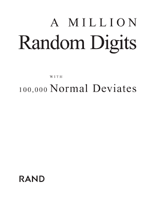 The new stream comes with a great many new numbers, that came about
when £PcM reacted to my tweet [27046726538]
on a uTube of
Morton
Feldman's 1964 piece Numbers by sending me a link
to another uTube clip 'reviewing' the Rand Corporation publication A
Million Random Digits with 100,000 Normal Deviates: a book with tables
of random numbers that "have become a standard reference in engineering
and econometrics textbooks and have been widely used in gaming and simulations
that employ Monte Carlo trials". Pondering this fine publication, for example as a pendant to On Kawara's 'One Million Years',
made me wish it were available as an audiobook. Or better still: to have an iThing app that would endlessly read out random numbers
in a voice of my choice - without beginning, without
end.
The new stream comes with a great many new numbers, that came about
when £PcM reacted to my tweet [27046726538]
on a uTube of
Morton
Feldman's 1964 piece Numbers by sending me a link
to another uTube clip 'reviewing' the Rand Corporation publication A
Million Random Digits with 100,000 Normal Deviates: a book with tables
of random numbers that "have become a standard reference in engineering
and econometrics textbooks and have been widely used in gaming and simulations
that employ Monte Carlo trials". Pondering this fine publication, for example as a pendant to On Kawara's 'One Million Years',
made me wish it were available as an audiobook. Or better still: to have an iThing app that would endlessly read out random numbers
in a voice of my choice - without beginning, without
end.
- Oct
01, [26059682681]
Artists lining up early Friday morning at #AFK, Piet Heinkade, to participate
in Amsterdam art grant lottery http://yfrog.com/5nbgasj
[[Burgwallen-Nieuwe Zijde, Amsterdam]]
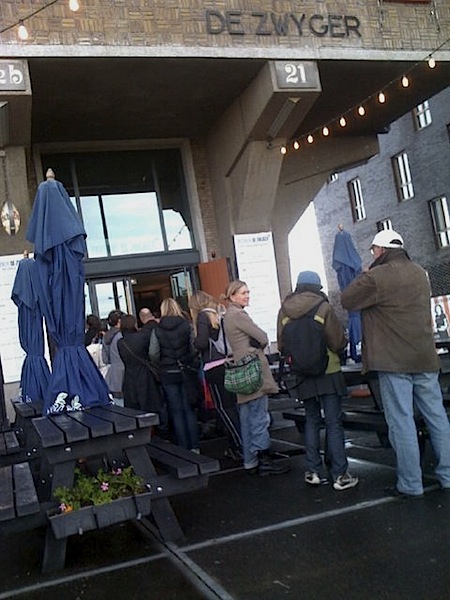
- Oct 02, [26151526839]
US Audio Fading Fast (@soundarchive ) http://t.co/zCDtaxW
("Fully digitalized culture may disappear without a trace" SB- http://j.mp/direv1)
]
[[Oude Pijp, Amsterdam]] - Oct 03, [26248093893]
Eugene Thacker on "Hideous Gnosis: Black Metal Theory Symposium", proceedings
of 2009 Brooklyn conf, @mutemagazine
- [ http://j.mp/blameth
]
[[Oost en Watergraafsmeer, Amsterdam]] - Oct 04, [26339502104]
Monoskop/log, living archive of writings on art, culture and media technology
(via @mediamatic) - [ http://j.mp/mnskplog
]
[[Maastricht, Limburg]]
Monoskop provides descriptions and links for a large and growing collection of (digital versions of) books and other printed publications on art, music, sound, culture, media, technology. A wonderful site and a valuable tool. Has become my favorite online library, ever since I found it.
- Oct
04, [26383180501]
Generative ambient music apps for the iThings quickly becoming sort of
like soaps or toothpastes, cf. http://j.mp/auraflx
@HigeFive
[[Maastricht, Limburg]] - Oct 05, [26434017334]
Soaps, toothpastes, generative ambient music apps: "Spend 10 minutes with
them twice a day," says @HigeFive
... :-) [ http://j.mp/apstts
]
[[Maastricht, Limburg]]
The avid viewer of this organ will know that I foresee a brilliant future for a music distributed and consumed not in the traditional format of tracks (that are always being played back in the same way, from a fixed beginning to an equally immutable end), but in the form of processes, the outcome of which may differ (with time, with place, or with whatever), and whose sounding output in general will have no fixed beginning. And will only 'end' when you turn them off: 'the music ends' only means that you stopped listening. The iThings (phone, pod, pad) and similar handy mobile computing devices present themselves as obvious platforms for the distribution of such 'sound processes'.
The above tweet then was sort of a 'sigh', as the music/process/apps that I currently see rising to the surface - like this auraflux - mostly seem to be of the generative ambient sort. Many apply a pretty similar 'box of tricks' and rely on a pretty similar sort of 'animated geometrico-graphical interface'. All are sort of 'cute' and fun toys to play around with. For a (in most cases: short) while.
Somewhat different from the generative ambient apps, I did enjoy playing around with this visually very attractive and versatile sequencer web app:
- Oct 25, [28671919781]
Musical 'ecosystem': breed sonic sequencer creatures using your web browser
as a Petri-dish (via @13bitstring)
> [ http://seaquence.org ]
[[Oude Pijp, Amsterdam]]
Still, the 'future of
music' will need other, new, ideas and directions.
And others, of course, may see music's future quite differently...
- Oct 10, [26916804595] "Future of music is analog because everything on internet is amateur" @freemusicarchiv on Fut. of Music Policy Summit - http://j.mp/fmscan
- Oct 05, [26433684973]
Fine @nulacc (Prague) filecasts,
like this detuned shortwave radio during thunderstorm + lofi rec of Uzbek
singer - [ http://nula.cc/55430
]
[[Maastricht, Limburg]] - Oct 06, [26539228294] AudioScope allows broadcasters to zoom in & select a specific sonic source in crowd (via @cityofsound) - [ http://bit.ly/bKztts ]
- Oct
06, [26538009871]
Got my #hardhoofddoek
at yesterday's @HardHoofd staff
meeting in the Cantine. Lang leve, @HardHoofd
! http://yfrog.com/4bmeqoj
[[Oude Pijp, Amsterdam]]

- Oct
07, [26631179323]
Park4dtv's digidivi heads at Belmondo, Amsterdam, serving the future.
http://yfrog.com/0evbeuj
[[Oude Pijp, Amsterdam]]
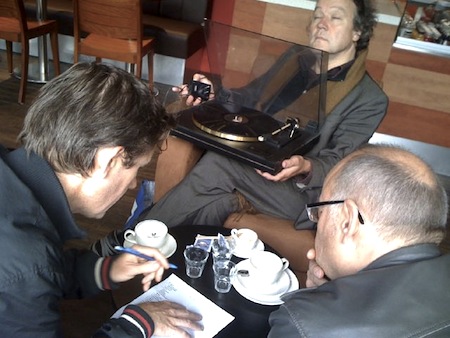
- Oct 08, [26724933389]
'Senza Misura' (Samson Young) 47 el. devices tick & blink to tempo
of movement from Beethoven's piano sonatas 1-14 - [ http://j.mp/bthticl
]
[[Oude Pijp, Amsterdam]] - Oct 08, [26776310808]
Nice marketing idea: free album download in exchange for tweet - [ http://www.stretta.com
(electronic, rather sweet really ] (via @cdmblogs)
[[Oude Pijp, Amsterdam]]
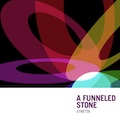 I
would probably never have downloaded nor listened to A Funneling Stone
by Stretta were it not for the fact that the download, in a way, was not
free. In order to get a copy of the album you are asked to send out a tweet
from a twitter account (to the effec that you just downloaded the album,
and linking to the
download page). I find this an interesting idea, which was
why I indeed did what Stretta asked me to do. And downloaded the album.
Somewhat to my surprise: it is not bad at all. Stretta (moniker
of Matthew
Davidson) made a 'modular synth only' album. For each of the tracks
he recorded the separate, monophonic, voices, one by one. There is (except for the 'sound', arguably)
nothing 'nostalgic' or 'retro' about the
music on A Funneling Stone, which is a coherent, varied & well-composed
analog synth album and a pleasure to listen to. (David wrote more on
his analog synths here
and here.)
I
would probably never have downloaded nor listened to A Funneling Stone
by Stretta were it not for the fact that the download, in a way, was not
free. In order to get a copy of the album you are asked to send out a tweet
from a twitter account (to the effec that you just downloaded the album,
and linking to the
download page). I find this an interesting idea, which was
why I indeed did what Stretta asked me to do. And downloaded the album.
Somewhat to my surprise: it is not bad at all. Stretta (moniker
of Matthew
Davidson) made a 'modular synth only' album. For each of the tracks
he recorded the separate, monophonic, voices, one by one. There is (except for the 'sound', arguably)
nothing 'nostalgic' or 'retro' about the
music on A Funneling Stone, which is a coherent, varied & well-composed
analog synth album and a pleasure to listen to. (David wrote more on
his analog synths here
and here.)
- Oct
09, [26831783293]
This we free (donation) download @ookoi's
'Tafelmuziek' album + 5 prev. unrel. tracks > http://j.mp/bacamuta
(ill. http://yfrog.com/7hhnj )
[[Oude Pijp, Amsterdam]]
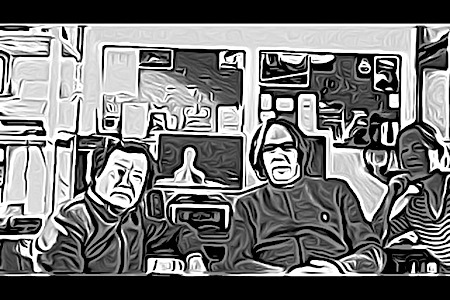
- Oct 10, [26913845249] An analog synth collector's wettest of dreams: Raymond Scott's Electronium, saved by Devo's Mark Motherbaugh - [ http://j.mp/eltrnm ]
- Oct 10, [26913845249] Scott never really finished building electronium. MM found it in bad, non-working shape. Rest. underway (via @vivaallmix) http://j.mp/mamdv
- Oct 11, [27011945089]
Great idea, marvelous show! DIY - mobile augmented reality - exhibition
@museummodernart NYC,
@sndrv - http://www.sndrv.nl/moma/
[[Oost en Watergraafsmeer, Amsterdam]]
Sander Veenhof and Mark Skwarek's art invasion of the NY Moma is a great example of a creative & playful use of the iThing's possibility to 'augment our reality'. As part of the 2010 edition of the Conflux Festival [26440517004], Sander and Mark used the Layar augmented reality browser to curate and install an - uninvited - exhibition of virtual works of art in the New York Museum of Modern Art. During the opening, visitors of the Moma could use their iPhone or Android device to find and view the works. This uTube will give you an impression of the event.
As the curators explain: being a virtual exhibition, there is no need to free the space,
whence the Layar 'AR exhbition' will remain available for an unlimited amount of time.
So, if you ever need
a good excuse to visit the Moma... :-)
[ The 'unlimited' availability also makes me wonder whether it would be possible
for others to invade the invasion? In other words: can one 'lock' (that is 'own' and thus 'sell') virtual space? Within
a specific app, yes of course, that would be possible (I do not know what is the policy of the Layar application in this respect).
I guess though that we're currently in an too early stage of virtual space's exploitation for this to be an issue. Not yet. ]
- Oct
12, [27113361082]
@disquiet Then invite listeners worldwide to tweet sound descriptions
using that #hashtag + geo. Will make fab. collection #soundtwit (?)
[[Oude Pijp, Amsterdam]] - Oct
12, [27114685786]
Clanking of mailbox & thud of morning paper on doormat. Upstairs neighbor
bumping down stairs. Door opens, door shuts. #eartwit
@disquiet
[[Oude Pijp, Amsterdam]] - Oct
13, [27217865038]
Loud shrieking of my stovetop kettle, until the steam launches the whistle.
Short metallic rattle as it lands on top of stove. #eartwit
[[Oude Pijp, Amsterdam]] - Oct 14, [27362577595] RT @gmp24_3 Call 1834 - House alarm sounding for last hour, Longsight #eartwit #gmp24
- Oct 14, [27362729527] RT @gmp24_3 Call 1856 - Unknown person banging at door #eartwit #gmp24
- Oct 15, [27414095247] RT @disquiet Baby's gurgles from the front of the house, birds squawking past in the back. #eartwit
- Oct 26, [28829886705] RT @disquiet Tuesday noon siren heard from inside ramen shop in SF's Union Square, muffled by walls, conversation, and slurping. #eartwit
In an early morning (for me) tweet on October 13th, I found Disquiet's Marc Weizenbaum (based in San Francisco) pondering what hash tag to use when (re-)tweeting descriptions of sounds & hears. I proposed #soundtwit. But Marc's #eartwit is shorter, hence better. Therefore #eartwit it became. Since that morning Marc (who, btw, also daily tweets his 'morningsounds'), and myself, every now and then add the hash tag #eartwit to a 'sound description' tweet. The tweets above are some examples. Over time this could result in an interesting collection of short descriptions of sonic moments from all over the world, and I do hope that some of you will join us in adding the hash tag to appropriate tweets. The idea of course is also to be able to access the collection by a Twitter search for #eartwit. Unfortunately (and, as far as I am concerned, a major drawback in trying to make it work) such a search currently returns only the very recent tweets marked #eartwit. Therefore, even though the collection actually is growing, for now it remains hidden within Twitter's database(s). Twitter is regularly expanding the possibilities of accessing and searching also older data, though. So I do hope that will change. Soon.
The short list of #eartwits above includes two re-tweets of the no less than 3.205 updates by the Greater Manchester Police on october 14th, who, in an interesting and a pretty spectacular 24 hour online action/experiment, tweeted every single incoming call and incident that they had to deal with.
- Oct 14, [27372620868] Each month Dutch composer writes 1 minute 'news topic opera' for prime-time TV. Oct.: @vanderaanet, Chilean miners > http://j.mp/wethaa
- Oct 16, [27519155358] More analog tape-drawings: pop portraits by Ghost in the Machine (via @DeNattePoedel, @theoploeg ) > [ http://j.mp/cassdraw ]
- Oct 21, [27992664689]
I enjoy flying above the old river Meuse & watch dinosaurs. Avoid
to fight #pterosaurs.
(No sound) > http://bit.ly/bzirWs
(@ballardian)
[[Vincennes, Paris]] - Oct 21, [28052825289]
"This painting is not available in your country" Paul Mutant, 2010. Acrylic
on canvas, 12" x 10" > [ http://j.mp/tpinaiyc
] (via @_neural)
[[Saint-Mandé, Paris]] - Oct 21, [28058352615] Pupils of next door's lycée on strike: Children of the Revolution, armed with 1 vuvuzela, 1 guitar & a lotta barely broken voices. @syntwit
- Oct 22, [28376866411]
"Musicians using science" - Short 'Renewalble music' note by Daniel Wolf
viz. Benoît Mandelbrot's recent passing > [ http://j.mp/mussci
]
[[Vincennes, Paris]]
- Oct 24, [28592509491]
Today's Paris meet: 29, rue Maurice Berteaux, Ivry s/Seine (mo Pte de Choisy). Impro libre, w/ Tejero + Martel, Lauzier, Bordé, Lopez // 17h
[[Vincennes, Paris]] - Oct
24, [28608902623]
4-tet: Martel, Lauzier, Bordé, Lopez - Kobé, Ivry s/ Seine - 24.10.10
http://yfrog.com/n5tf4tj
[[Ivry-sur-Seine, Paris]]
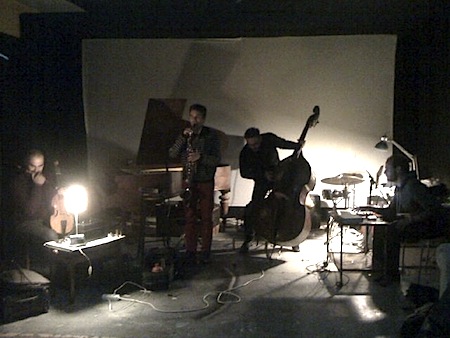
- Oct
25, [28668809167]
"Déchant pour walkman" - A requiem for the walkman > [ http://j.mp/ripwalkman
] (via / RT @syntwit)
[[Vincennes, Paris]] - Oct
26, [28668809167]
My fav autorev dictaphone's gone. Looked everywhere. Nothing :( She must've caught some o'the fuss
over Sony halting her kind's production.
[[Île-de-France, France]]
The announcement last month that Sony ceased production of all cassette Walkmans and will stop selling them in Japan as soon as the current inventory runs out (cf.: カセットウォークマン販売終了 30年の歴史に幕 ; Google proposes a wonderful dadaist translation of the Japanese 'カセットウォークマン' as: Kasettouokuman) sent something of a buzzing ripple of regrets & rip's over the ocean of blogs and twitter accounts that I keep an eye on. But Sony's decision is of course only logical in view of the undisputable fact that the golden era of the consumer cassette tape has long come to an end. Though I obviously do have a pretty intense working relationship with analog (cassette) tape, and hence with small and big machines that enable their use, contrary to what one often seems to almost take for granted, this relationship is not based on anything even remotely related to whatever form of 'nostalgia' or 'fetishism'. Little 'regret' therefore on my side. I wish Sony all the best, and hope that, rather than continue to pump out cassette machines, in the near future they will actually come up with something new that will prove as revolutionary and globally habit-changing & -defining as the old taperunner.
 Which,
on the other hand, did not prevent me from being mighty annoyed that I seemed to have misplaced (or maybe even lost)
my own favorite autoreverse Sony dictaphone, when a couple of weeks ago
I was packing my stuff for the Basel Shift festival. I had not the slightest
idea where the little bugger could be hiding, and eventually had to head for the festival without it.
The tcm500dv is the
only model that I currently still own with the handy instant side reverse
switch that I use for sudoku
play, which, indeed, makes it the Stradivarius among the instruments
that I use for live performances. It was but little consolation that musicians
do seem to be in the habit of leaving
their stradivarii behind... on trains, busses and in cabs.
Which,
on the other hand, did not prevent me from being mighty annoyed that I seemed to have misplaced (or maybe even lost)
my own favorite autoreverse Sony dictaphone, when a couple of weeks ago
I was packing my stuff for the Basel Shift festival. I had not the slightest
idea where the little bugger could be hiding, and eventually had to head for the festival without it.
The tcm500dv is the
only model that I currently still own with the handy instant side reverse
switch that I use for sudoku
play, which, indeed, makes it the Stradivarius among the instruments
that I use for live performances. It was but little consolation that musicians
do seem to be in the habit of leaving
their stradivarii behind... on trains, busses and in cabs.
I do not know whether also these 'cassette notebooks' are part of the range of portable cassette players that Sony will no longer be producing. They are not 'walkmen', strictly speaking. But maybe should get me another one before all stock runs out, and then finally finish that 'sudoku' album I've been working on since 2006 :-) ...
Which makes me wonder... Anyone ever used a dictaphone as a murder weapon?
...
[ Update: Meanwhile found the tcm500dv. I had left it in a shoe box in Amsterdam, under a pile of snail-mail, magazines and other stray papers. ]
- Oct 27, [28864646089]
Pierre Gordeeff's "The Built from Scratch Apparatus" Great visuals &
sound @rhizomedotorg > [ http://j.mp/bfscratch
]
[[Vincennes, Paris]]
...
More SB Tweet Digest in December.
! Follow @soundblog
_( ![]() )_ resonancenet@ wolloF
!
)_ resonancenet@ wolloF
!
...
tags: twitter, digest
# .395.
comments for SB Tweet Digest #9 ::
|
Comments are disabled |
